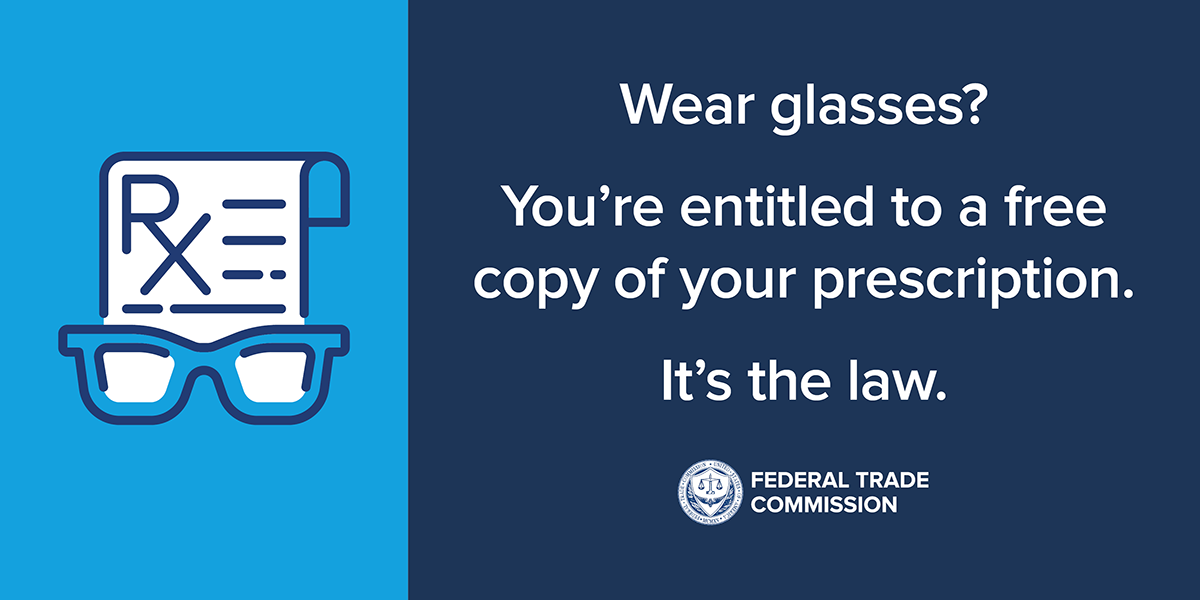
Concluding a comprehensive multi-year review, the Federal Trade Commission today announced final updates to its Ophthalmic Practice Rules, known as the Eyeglass Rule aimed at promoting competition and consumer choice.
The updates are designed to increase compliance with the rule’s longstanding requirement that eye doctors (ophthalmologists and optometrists) provide patients with a free copy of their prescription immediately following a refractive eye exam. The revised rule requires that in certain circumstances, prescribers must request a patient’s signature confirming they received their prescription, and prescribers must keep a record of that confirmation for at least three years.
“For decades, the FTC’s Eyeglass Rule has promoted competition by ensuring that consumers can shop around for lower prices,” said Samuel Levine, Director of the Bureau of Consumer Protection. “The FTC’s updated rule will strengthen compliance and make this market more fair and competitive.”
Issued in 1978, the FTC’s Eyeglass Rule helps facilitate consumer choice and promote competition in the eyeglass market by requiring that prescribers automatically provide patients with a copy of their eyeglass prescription immediately after any eye exam that includes a vision test, also known as a refraction, even if the patient does not request the prescription.
Under the existing rule, prescribers cannot require that patients buy eyeglasses before providing them with a copy of their prescription, place a liability waiver on the prescription, require patients to sign a waiver in order to receive their prescription, or require that patients pay an additional fee in exchange for a copy of their prescription. Prescribers also cannot refuse to perform an eye exam unless the patient buys eyeglasses, contact lenses, or other ophthalmic goods from them.
Rule Review and Final Changes
Despite the rule’s longstanding existence, prescribers have not always complied with the automatic release requirement. In response to consumer complaints over the past several years, the FTC has sent warning letters to prescribers reminding them that they must provide patients with prescriptions at the end of an exam and cannot charge a fee or require eyeglass purchase for prescription release. But even so, surveys of consumers have repeatedly found that many consumers do not automatically receive their prescription following each refractive eye exam.
In December 2022, after receiving more than 800 public comments, the Commission proposed updating the rule to address the continued non-compliance. The Commission sought additional comment on the proposed changes and held a public workshop in May 2023.
The changes announced today require that prescribers, after providing the prescription, request that their patients sign a statement confirming they received their prescription and keep a record of such confirmation for at least three years. These new confirmation requirements—which mostly mirror those already in place for contact lens prescriptions—only apply to optometrists and ophthalmologists who have a financial interest in selling prescription eyewear.
Other changes to the rule:
- allows prescribers, with a patient’s verifiable affirmative consent, to provide the patient with a digital copy of a prescription in lieu of a paper copy; if the patient refuses the digital copy, the prescriber must provide a paper copy;
- explicitly specifies that, whether the patient consents to digital delivery or opts for a paper copy of their prescription, the prescription must be provided immediately after the examination is completed (not after the patient has been sold glasses, for instance). A patient must have their prescription before any offer to sell them glasses.
- clarifies that presentation of proof of insurance coverage shall be deemed to be a payment for the purpose of determining when a prescription must be provided.
- changes the term “eye examination” to “refractive eye examination” throughout the text and emphasizes the need for prescribers to educate consumers that there can be a difference between an eye health examination and a refractive eye examination. This is because the automatic release of prescriptions is only required following a refractive eye examination.
The Commission vote approving the final rule was 5-0, with Commissioner Rebecca Kelly Slaughter issuing a separate statement. It will be published in the Federal Register soon and will become effective 60 days after publication.
The primary staffer who worked to develop the final rule is Alysa Bernstein in the FTC’s Bureau of Consumer Protection.
Information for Consumers and Businesses
The FTC has information to help consumers understand their rights under federal law. See: Buying Prescription Glasses or Contact Lenses: Your Rights. Information to help businesses comply with the rule also is available.
Official news published at https://www.ftc.gov/news-events/news/press-releases/2024/06/ftc-announces-final-eyeglass-rule-implementing-updates-promote-competition-expand-consumer-choice


